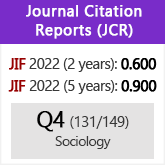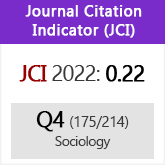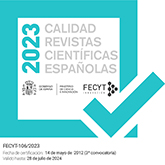Modes of survey and response quality
DOI:
https://doi.org/10.3989/ris.2019.77.1.17.135Keywords:
Acquiescence, Face to face interviews, Mixed mode surveys, Response effects, Telephone surveysAbstract
In this work we make a comparison between a face-to-face and landline CATI survey using two equivalent samples. The questionnaire has forced-choice questions with vertical disposition of the answers, and grid questions. In the first part we compare the presence of answer effects (primacy and recency) and the number of answers “not know”. The telephone survey has fewer partial nonresponse, and presence of recency effect in questions with vertical disposition with 4 and 5 categories. In the battery questions we verify if the telephone surveys have a smaller degree of differentiation in the scales, a greater election of extreme answers, as well as a greater assent. This phenomenon has been detected in the questions of 5 and 10 categories of answer, not detecting effect primacy in questions administered with card.
Downloads
References
Alós, J. 2001. "Industria de los estudios de mercado en Espa-a 2000". Investigación y Marketing 72: 72-74.
ANEIMO-AEDEMO-ESOMAR. 2017. "El sector de la investigación de mercados mundial adquiere velocidad de crucero". Disponible en http://www.aedemo.es/aedemo/estudio-industria [Consulta 15 de noviembre de 2016].
Bowers, J. y M. J. Ensley. 2003. Issues in Analyzing Data from the Dual-Mode 2000 American National Election Study. Ann Arbor: Universidad de Michigan, NES.
Bradburn, N. M. 1983. "Response Effects". Pp. 289-328 en Handbook of Survey Research. Nueva York: Academic Press. https://doi.org/10.1016/B978-0-12-598226-9.50014-8
Callegaro, M., K. Lozar Manfreda y V. Vehovar. 2015. Web Survey Methodology. Londres: Sage.
Cea D'Ancona, M.Á. 2010. Métodos de encuesta. Madrid: Síntesis.
Chang, L. y J. A. Krosnick. 2010. "Comparing oral interviewing with self-administered computerized questionnaires: an experiment". Public Opinion Quarterly 74: 154-167. https://doi.org/10.1093/poq/nfp090
Díaz de Rada, V. 2014. "Complementación entre encuestas presenciales y telefónicas". Política y Sociedad 51; 201-226. https://doi.org/10.5209/rev_POSO.2014.v51.n1.42431
Díaz de Rada, V. 2011. "Utilización conjunta de encuesta presencial y telefónica en encuestas electorales". Revista Internacional de Sociología 69, 393-416. https://doi.org/10.3989/ris.2009.01.10
Díaz de Rada, V. 2010. Comparación entre los resultados obtenidos por encuestas personales y telefónicas: el caso de una encuesta electoral. Madrid: CIS.
Díaz de Rada, V. 2015. "Tipos de Encuestas". Pp. 363-390, en El Análisis de la Realidad Social, Madrid: Alianza.
Díaz de Rada, V. e I. Portilla. 2015. "Encuestas telefónicas: estrategias para mejorar la colaboración". Perspectiva Empresarial. 2: 97-115. https://doi.org/10.16967/rpe.v2n1a7
Dillman, D. A., J. D. Smyth y L. M. Christian. 2009. Internet, Mail and Mixed-Mode Surveys: The Tailored Design Method (3ª edición). Nueva York, Wiley.
Ellis, Ch. H. y J. A. Krosnick. 1999. Comparing telephone and face to face surveys in terms of sample representativeness: a Meta-Analysis of Demographics Characteristics. Ann Arbor: Universidad de Michigan, NES.
Gabardo Vallejo, J.A. 2013. "Las ventajas de los estudios con más de una metodología de realización de entrevistas". Paper presented at 1st Southern European Conference on Survey Methodology (SESM), December 12th -14th Barcelona.
Galán, I., F. Rodríguez y B. Zorrilla. 2004. "Comparación entre encuestas telefónicas y encuestas 'cara a cara' domiciliarias en la estimación de hábitos de salud y prácticas preventivas". Gaceta Sanitaria 18: 440-50. https://doi.org/10.1016/S0213-9111(04)72031-2
Galesic, M., R. Tourangeau, M. P. Couper y F. Conrad. 2008. "Eye-tracking data: New Insights on Response Order Effects and Other Cognitive Shortcuts in Survey Responding". Public Opinion Quarterly 72: 892-913. https://doi.org/10.1093/poq/nfn059
Green, M. C., J. A. Krosnick y A. L. Holbrook. 2001. "The survey response process in telephone and face-to-face surveys. Disponible en: https://pdfs.semanticscholar. org/d4d8/42f48a2109e094fc6590f69e386940e2e32e. pdf [Consultado el 29 de enero de 2019].
Groves, R. M. y L. Kahn. 1979. Surveys by telephone: a national comparison with personal interviews. Orlando, FL.: Academic Press.
Groves, R. M. y L. Lyberg. 2010. "Total survey error: past, present and future". Public Opinion Quarterly 74: 849-879. https://doi.org/10.1093/poq/nfq065
Gwartney, P.A. 2007. The Telephone Interviewer's Handbook: How to conduct standardized conversations. San Francisco: Jossey-Bass.
Häder, S., M. Häder y M. Kuhne. 2012. "Introduction: telephone surveys in Europe". Pp. VII-XIII en Telephone Surveys in Europe: Research and Practice. Manheim: Springer Verlag. https://doi.org/10.1007/978-3-642-25411-6
Heerwegh, D. 2009: "Mode differences between face-to-face and web surveys: An experimental investigation of data quality and social desirability effects". International Journal of Public Opinion Research 21: 111-120. https://doi.org/10.1093/ijpor/edn054
Holbrook, A.L., M. C. Green y J. A. Krosnick. 2003. "Telephone versus face-to-face interviewing of national probability samples with long questionnaires". Public Opinion Quarterly 67: 79-125. https://doi.org/10.1086/346010
Holbrook, A.L, J. A. Krosnick, D. Moore y R. Tourangeau. 2007. "Response order effects in dichotomous categorical questions presented orally: the impact of question and respondent attributes". Public Opinion Quarterly 71: 325-348. https://doi.org/10.1093/poq/nfm024
Instituto de Estudios Avanzados-IESA 2010. Barómetro de opinión Pública de Andalucía. Córdoba: IESA.
Jordan, L.A., A. C. Marcus y L. G. Reeder. 1980. "Response styles in telephone and household interviewing: a field experiment". Public Opinion Quarterly 44: 102-111. https://doi.org/10.1086/268585
Körmendi, E. y J. Noordhoek. 1989. Data quality and telephone interviews. Copenhagen: Danmark Statistik.
Krosnick, J.A. 1999. "Survey research". Annual Review of Psychology 50: 537-567. https://doi.org/10.1146/annurev.psych.50.1.537
Krosnick, J.A. y D. F. Alwin. 1987. "An Evaluation of a Cognitive Theory of Response Order Effects in Survey Measurement". Public Opinion Quarterly 51: 201-219. https://doi.org/10.1086/269029
Krosnick, J. A., A. L. Holbrook, M. K. Berent, R. T. Carson, W. M. Hanemann, R. J. Kopp, R. Cameron Mitchell, S. Presser, P. A. Ruud, V. K. Smith, W. R. Moody, M. C. Green and M. Conaway. 2002. "The Impact of "No Opinion" Response Options on Data Quality: Non-Attitude Reduction or an Invitation to Satisfice?". Public Opinion Quarterly 66: 371-403. https://doi.org/10.1086/341394
Lavrakas, P. J. 2010. "Telephone survey". Pp. 471-498 en Handbook of Survey Research (segunda edición), Bingley: Emerald Group Publishing Limited.
Lavrakas, P. J. 2013. "Presidential address: applying a total error perspective for improving research quality in the social, behavioral, and marketing sciences". Public Opinion Quarterly 74: 831-850. https://doi.org/10.1093/poq/nft033
Leeuw, E.D. de 1992. Data Quality in Mail, Telephone and Face to Face Surveys. Amsterdam: TT-Publikaties.
Leeuw, E.D. de 2005. "To Mix or Not to Mix Data Collection Modes in Surveys". Journal of Official Statistics 21 (2): 233-255.
Leeuw, E.D. de 2008. "Choosing the method of data collection". Pp. 113-115 en International Handbook of Survey Methodology, Nueva York: Lawrence Erlbaum Associates and European Association of Methodology.
Leeuw, E.D. de y J. J. Hox. 2015. "Survey mode and mode effects". Pp. 22-34, en Improving survey methods. Lessons from recent research. New York: Routledge.
Leeuw, E.D. de y J. Van der Zouwen. 1988. "Data quality in telephone and face to face surveys: a comparative meta-analysis". Pp. 283-298, en Telephone Survey Methodology, Nueva York: Wiley.
Loosveldt, G. 2008. "Face to face interviews". Pp. 201-220 en International Handbook of Survey Methodology. Nueva York: Lawrence Erlbaum Associates y Asociación Europea de Metodología.
Lyberg, L. 2012. "Survey Quality". Survey Methodology 38: 107-130.
McCarty, J. A. y L. J. Shrum. 2000. "The measurement of personal values in survey research: a test of alternative rating procedures". Public Opinion Quarterly 64: 271- 298. https://doi.org/10.1086/317989
Narayan, S. y J. A. Krosnick. (1996): "Education Moderates some Response Effects in a Attitude Measurement". Public Opinion Quarterly 60: 58-88. https://doi.org/10.1086/297739
Nicolaas, G., K. Thomson y P. Lynn. 2000. The feasibility of conducing Electoral Surveys in the UK by telephone. Londres: NatCen.
Pasadas del Amo, S., M. Soria Zambrano y M. Zarco. 2006. "¿Dónde están los jóvenes? Un análisis de las dificultades de localización y acceso al segmento juvenil en las encuestas telefónicas". Paper presented at IV Congreso de Investigación mediante Encuestas, September 24-26, Pamplona.
Peleteiro, I. (2012): "La incorporación de las líneas móviles al marco muestral de las encuestas telefónicas", Investiga, 38: 12.
Petersen, T. 2008: "Split Ballots as an experimental approach to public opinion research". Pp. 322-329, en The SAGE Handbook of Public Opinion Research, Thousand-Oaks, LA: Sage. https://doi.org/10.4135/9781848607910.n30
Riba, C., M. Torcal y L. Morales. 2010. "Estrategias para aumentar la tasa de respuesta y los resultados de la Encuesta Social Europea en Espa-a", Revista Internacional de Sociología, 68: 603-635. https://doi.org/10.3989/ris.2008.12.17
Salinas, J. M., A. Calvo y M. C. Aguilar. 2004. "Un análisis comparativo entre la entrevista telefónica y la entrevista presencial en la determinación de la prevalencia de los juegos de azar". Metodología de Encuestas 6: 119-132.
Sykes, W. y G. Hoinville. 1985. Telephone interviewing on a survey of social attitudes. A comparison with face-to-face procedures. London: SCPR.
Sykes, W. y M. Collins. 1988. "Effects of Mode of Interview: Experiments in the UK". Pp. 301-345, en Telephone Survey Methodology, Nueva York: Wiley.
Toepoel, V. 2015. Doing survey Online. Londres: Sage. https://doi.org/10.4135/9781473967243
Tucker, C. y J. M. Lepkowski. 2008. "Telephone survey methods: adapting to change". Pp. 3-26, en Advances in telephone survey methodology. Nueva York: Wiley.
Ye, C., J. Fulton y R. Tourangeau. 2011. "More positive or More Extreme? A Meta-Analysis of Mode Differences in Response Choice". Public Opinion Quarterly 75: 349-365. https://doi.org/10.1093/poq/nfr009
Zhang, Ch. y F. Conrad. 2014. "Speeding in Web Surveys: the Tendency to answer fast and its association with straightlining". Survey Research Methods 8: 127-135.
Published
How to Cite
Issue
Section
License
Copyright (c) 2019 Consejo Superior de Investigaciones Científicas (CSIC)

This work is licensed under a Creative Commons Attribution 4.0 International License.
© CSIC. Manuscripts published in both the printed and online versions of this Journal are the property of Consejo Superior de Investigaciones Científicas, and quoting this source is a requirement for any partial or full reproduction.All contents of this electronic edition, except where otherwise noted, are distributed under a “Creative Commons Attribution 4.0 International” (CC BY 4.0) License. You may read here the basic information and the legal text of the license. The indication of the CC BY 4.0 License must be expressly stated in this way when necessary.
Self-archiving in repositories, personal webpages or similar, of any version other than the published by the Editor, is not allowed.

















